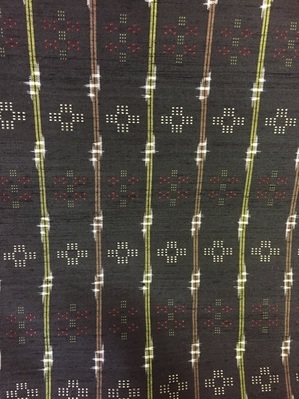 Supplier: Haraguchi gofuku [http://kimono-haraguchi.jp/]
Supplier: Haraguchi gofuku [http://kimono-haraguchi.jp/]
- Woven textiles
- Okinawa
Flower pattern textiles Haebaru hanaori
Beautiful patterns created by
flower filaments of many colors
Description
What is Flower pattern textiles ?
Haebaru flower patterned textiles called Haebaru Hanaori in Japanese, are made in the city of Haebaru in the Okinawa Prefecture. Plants harvested in the prefecture such as garcinia or Assam indigo are used to dye the yarns. Haebaru Hanaori can be characterized by their beautiful flower-like patterns that look three-dimensional. Many years of work and experience are necessary to perfect the techniques that make the detailed patterns of Haebaru Hanaori to look like embroidery at a glance.
History
The history of Haebaru Hanaori goes back to the Meiji period (1868-1912). In 1914, a school for girls was built in the city of Haebaru where many girls and women learned the traditional techniques of weaving flower patterned textiles. There, they modernized the traditional techniques to create a unique, new art. After World War II, the villagers that had survived lived in great poverty and started to collect different materials in the hope of restoring their art of textile. Producing their unique fabric was their main goal, and they have kept on reinventing it and adapting to changing customers' needs up to now.
Production Process
- 1. Designing The design is drawn on graph paper.
- 2. Warping The length and numbers of the warp threads are arranged.
- 3. Dyeing the threads The threads are dyed using indigo or fukugi. The parts to become kasuri (splashed patterns) are tied.
- 4. Starching the threads To prevent the kasuri patterns from moving, the warp threads are starched.
- 5. Reed threading The warp threads are threaded through the heddle (where the threads are moved up and down on the weaving machine) and the reed (a comb-like wooden part to keep the space betwen the threads even).
- 6. Preparing to weave The warp threads are tied to the cloth beam where the woven cloth will be wrapped around to prepare for weaving.
- 7. Weaving The warp threads are moved up using the heddle , and the weft threads are passed through with the shuttle. Beautiful three dimensional flower-like patterns can be woven by skipping 2 - 3 threads and using 8 - 10 heddles.
- 8. Steaming After washing off the starch with water, the cloth is smoothed with steam. The width and length of the cloth are arranged by tentering.
Other Woven textiles
- Nishijin brocade
- Yuki tsumugi silk
- Kurume traditional resist-dyed textiles
- Ojiya chijimi textiles
- Hakata brocade
- Ushikubi tsumugi silk
- Chichibu-meisen silk
- Miyako ramie textile
- Shiozawa tsumugi silk
- Kumejima tsumugi silk
- Omi ramie cloth
- Ryukyu traditional resist-dyed textiles
- Kiryu brocade
- Murayama-oshima tsumugi silk
- Yumihama traditional resist-dyed textiles
- Chibana-hanaori textiles
- Hon-shiozawa silk
- Oitama tsumugi silk
- Ojiya tsumugi silk
- Yaeyama cotton cloth
- Yaeyama ramie cloth
- Honba oshima tsumugi silk
- Shinshu tsumugi silk
- Shuri brocade
- Tama brocade
- Yomitanzan-hanaori textiles
- Isesaki traditional resist-dyed textiles
- Hachio island silk
- Nibutani bark cloth
- Uetsu tilia bark cloth
- Awa-shijira cotton cloth
- Kijoka banana fiber cloth
- Tokamachi traditional resist-dyed textiles
- Tokamachi akashi chijimi textiles
- Yonaguni brocade
- Yuntanza minsa
- Flower pattern textiles
- Oku-Aizu Showa Karamushi Textiles
Other Crafts Made in Okinawa
- Tsuboya ware
- Miyako ramie textile
- Ryukyu lacquerware
- Kumejima tsumugi silk
- Ryukyu traditional resist-dyed textiles
- Chibana-hanaori textiles
- Yaeyama cotton cloth
- Yaeyama ramie cloth
- Shuri brocade
- Yomitanzan-hanaori textiles
- Ryukyu traditional textiles
- Kijoka banana fiber cloth
- Yonaguni brocade
- Yuntanza minsa
- Flower pattern textiles
- Sanshin































































































































































































































































































